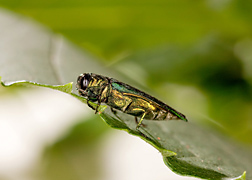This page has been archived and is being provided for reference purposes only. The page is no longer being updated, and therefore, links on the page may be invalid.
| Read the magazine story to find out more. |
|
|
|
|
Scientists Exploit Ash Tree Pest's Chemical Communication
By Jan SuszkiwApril 7, 2011
A newly identified chemical sex attractant, or pheromone, of the emerald ash borer could mean improved traps for monitoring and controlling the tree-killing beetle. That's the goal of U.S. Department of Agriculture (USDA) entomologist Allard Cossé and his colleagues.
Cossé has been searching for such attractants since 2007 as part of a multidisciplinary team of scientists from USDA's Agricultural Research Service (ARS), Forest Service (FS) and Animal and Plant Health Inspection Service (APHIS). Early success came with the identification of several attractants emitted from the bark and leaves of girdled ash trees.
That finding, in turn, led to the development of traps baited with manuka oil as a less-expensive proxy. The traps are now used to detect infestations of borers so that quarantine areas can be established to contain them.
More recently, the team discovered a macrocyclic lactone, a compound that female borers release while feeding. Large-scale field tests conducted in Canada and the United States showed that the compound attracts male borers and has potential for use in traps either alone or combined with ash-tree-based attractants, reports Cossé, at the ARS National Center for Agricultural Utilization Research in Peoria, Ill.
A key tool throughout the team's studies has been the electro-antennogram. The device records the strengths of electrical signals generated by the borer's antenna when connected to electrodes and exposed to different odors it encounters in nature.
The electro-antennogram has also proven useful in identifying attractants for three parasitic wasp species that have been approved for release as biological control agents. The team has so far developed an experimental pheromone formulation for one of the three wasp species, Spathius agrili, which attracts males and females alike.
Establishing natural enemies such as the wasps could help slow down the spread of the borer, creating a kind of equilibrium whereby fewer trees are lost to the beetle pest, according to Cossé.
Read more about this research in the April 2011 issue of Agricultural Research magazine.
ARS is USDA's principal intramural scientific research agency.

